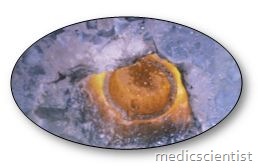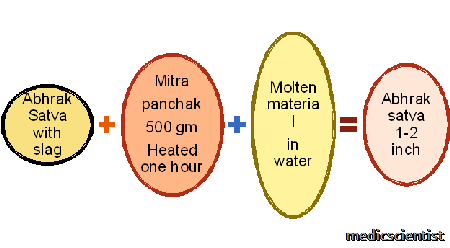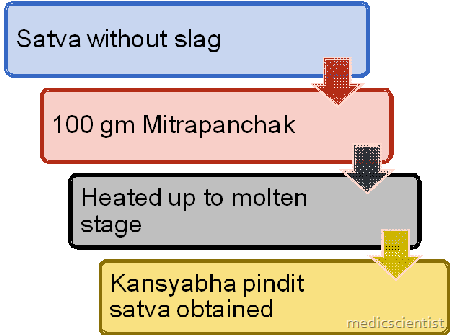Abhrak bhasma Satva patan Satva Sodhan and Churnikaran Methods
s.o.p of satva bhasma w.s.r to abhrak satva bhasma Pure Abhrak Bhasma,Powdered Abhrak Bhasma
Introduction Abhrak bhasma Satva patan Satva Sodhan
- Pure Abhrak Bhasma,Powdered Abhrak Bhasma
- § As per the Rasa text Satva bhasma has been claimed to be more efficacious then other Iron Bhasmas for the treatment of diseases and to positive health.
- § Diabetes mellitus,TB or to improve immunity
- & to promotes physical & mental vigour etc.
- § Quality control is need of the hour.
- § To assure the quality & to establish the standards for Abhrak satva bhasma an attempt was made in this regards .

Abhrak bhasma Satva patan Satva Sodhan and Churnikaran Methods
Three steps — Abhrak bhasma Satva patan Satva Sodhan
- 1
-
- 2
-
- 3
-
- Krishnabhraka
- Sanskrit- Abhrak
- English- Mica
- Krishnabhraka
- Sanskrit- Abhrak
- English- Mica
Satva patan :
- § Satvapatan means extraction of desired metal or alloy from a mineral for the prepration of bhasma.
Four steps Rasa Tarangani
- 1. Purification or refining of the mineral.
- 2. Mixing with the reductant and flux etc.
- 3. Agglomeration.
- 4. Smelting.

Satva dravikaran

Satva pindikaran

| Material |
Sample (1) |
Sample (2) |
Sample (3) |
| Biotite |
5 kg |
5 kg |
5 kg |
| Borax |
1 kg 250 gm |
1 kg 250 gm |
1 kg 250 gm |
| Sweta Musli |
2 kg |
2 kg |
2 kg |
| Water for Kwatha |
20 lit |
20 lit |
20 lit |
| Wt of the balls |
8 kg |
7 kg |
8.2 kg |
| Total time in Satv patan |
6 hour |
6 hour |
7 hour |
| Wt of Mitrapanchak for pindikaran |
100 gm |
100 gm |
100 gm |
| Wt of satva obtained |
495 gm |
490 gm |
500 gm |
Satva Sodhan &Churnikaran
Four steps Rasa Tarangani
- Pure Abhrak Bhasma,Powdered Abhrak Bhasma
-
- 1. Heating & quenching (Nirvapan).
- 2. Powdering.
- 3. Roasting & Trituration.
- 4. Bhavna & Mardan.
Abhrak Satva Maran

| Material |
Sample (1) |
Sample (2) |
Sample (3) |
| Abhrak Satva |
400 gm |
400 gm |
400 gm |
| Kanji for one nirvap |
2 lit |
2 lit |
2 lit |
| Wt of powdered satva |
410 gm |
412 gm |
415 gm |
| Amalki kwath for Bhavana & 3 Roasting |
3 lit |
3 lit |
3 lit |
| Cow ghee for 3 time roasting |
450 gm |
450 gm |
450 gm |
| Punarnava Swarasa for Bhavana |
500 ml |
500 ml |
500 ml |
| Vasa swarasa for Bhavana |
300 ml |
300 ml |
300 ml |
| Kanji for Bhavana |
300 ml |
300 ml |
300 ml |
| Wt of final product |
420 gm |
415 gm |
422 gm |
Successive steps
Kupi pakva Vidhi
- (Process repeated two time in each sample)
| Material |
Sample (1) |
Sample (2) |
Sample (3) |
| Abhrak Satva churna |
240 gm |
240 gm |
240 gm |
| Sudh Parad |
60 gm |
60 gm |
60 gm |
| Sudh Gandhak |
60 gm |
60 gm |
60 gm |
| Time taken in kajjli formation |
24 hour |
24 hour |
24 hour |
| Wt of kajjli |
490 gm |
490 gm |
490 gm |
| Time in kupipaka |
12 hour |
12 hour |
12 hour |
| Wt of Satva Sindur |
110mg |
100mg |
104mg |
| Wt of Satva bhasma |
265 gm |
270 gm |
263 gm |
| Wt of bhasma after 2nd k.paka |
316 gm |
310gm |
315gm |
Puta pakva Vidhi

Ancient tests mentioned for Physico – chemical analysis of Bhasma
- 1. Nischandratwa(Without shining or luster)
- 2. Rekhapurna(enter into furrows of figure)
- 3. Anjansadrisha( fine like collyrium)
- 4. Laghuta ( lightness)
- 5. Varitar ( Floates over water & unam )
- 6. Mruduta ( softness)
- 7. Slakhnatva. ( Smoothness )
- 8. Nirdhoomatwa ( smokeless)
¢ B)
- 1. Niruthatwa (not regaining it’s original form.)
- 2. Apunarbhavatwa (not regaining it’s original
- form.)
- 3. Gatarasatwa (tastelessness / swadarahita)
- 4. Avami (No vomiting sensation)
- 5. Amlatva pariksha (test with sour – juice )
II.Method For Standardisation :
- • Organoleptic characters
- • Qualitative & Quantitative analysis by
- Inductively coupled Plasma Atomic
- Emmission Spectroscopy.
- • PH value , Moisture content, Ash
- value were noted.
1.Organoleptic characters ofAbhrak bhasma:
| Characters |
Suddh Abhrak |
S.Abhrak Satva |
Abhrak Satva Bhasma |
| Color |
Krishna |
Dhuser |
Brick Red |
| Odour |
Dhanya gandhi |
Odourless |
Odourless |
| Taste |
Tasteless |
Tasteless |
Tasteless |
| Touch |
Smooth |
Smooth |
Smooth |
| Appearance |
Powder |
Powder |
AmorphusPowder |
Physical constants of Abhraka Satva Bhasma
| Characters |
Suddh Abhrak |
S.Abhrak Satva |
Abhrak Satva Bhasma |
| Moistre content |
0.43 % |
0.037 % |
1.27 % |
| Acid insoluble content |
48.52 % |
1.32 % |
6.87 % |
| Water soluble |
0.46% |
0.43% |
11.46% |
| Ash value |
96.61% |
122.14 % |
90.56% |
| PH value |
10.77 |
7.73 |
3.83 |
Elements —
| Elements |
S. Abhrak |
S.Abhrak Satva |
A.S. Bhasma |
| Fe2O3 |
14.14 |
85.9 |
56 |
| MgO |
7.44 |
0.0586 |
0.0648 |
| Al 2 O3 |
17.16 |
0.290 |
0.405 |
| K2O |
5.75 |
0.057 |
0.210 |
| Zn |
0.02 |
0.0073 |
0.0273 |
| Cd |
– |
0.0010 |
0.0008 |
| Pb |
– |
0.0068 |
0.0068 |
CONCLUSION
- ¢ Iron ,Magnessium , Aluminium , Silicon ,
- Calcium, Potassium within permissible amount
- and Zinc,Tin,Barium,Phosphorous,Manganese
- in trace amount were detected in Abhrak Satva Bhasma.
- ¢ Significant increase in percentage of Iron
- as compared to % of Iron in Raw.
- • Percentage of Abhrak Satva obtained was — 10 %.
- • After sodhan increased wt of Abhrak Satva was – 2.5 %.
- • After Kupipaka method increase in wt of Satva Bhasma was – 31.66 %.
- • Wt of Satva Sindur obtained by Putpaka method was – 220 mg.
- • After putpaka method no increase in wt of Satva Bhasma was observed.







